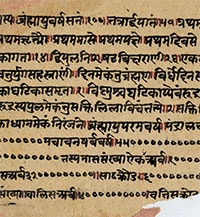Originally published in the Union College Magazine, Fall 2012
When most people think math, they think fractions, formulas, variables, graphs – the antithesis, some might say, of lyrical or poetic expression. But words in verse were once integral to mathematical thinking, learning and communication.
"The medieval Sanskrit textbooks developed quite an elaborate system of mathematical notation," Kim Plofker said. “These texts described mathematical results and methods verbally, rather than in symbolic notation, though users carrying out computations had an intricate toolkit of numerals and symbols.
"The norm in Sanskrit was to compose treatises and textbooks in strictly structured metrical (but non-rhyming) verse. This was helpful in memorizing rules and formulas, as you know if you’ve ever learned to sing the quadratic formula to 'Pop Goes the Weasel.'"
Plofker studies this ancient Indian mathematical tradition to understand where, when and how various mathematical ideas and methods originated, and how these methods have influenced modern practices.
"It's still very much an open question how much Sanskrit mathematics directly influenced early European math,” she said. "But we do know of several crucial features that came to us from Indian mathematics via the Arabic scholarly tradition, such as our decimal place-value numerals."
"And there are also our basic trigonometric functions of sine and cosine," Plofker added. "The very name sine comes to us from Sanskrit, though in a roundabout way."
